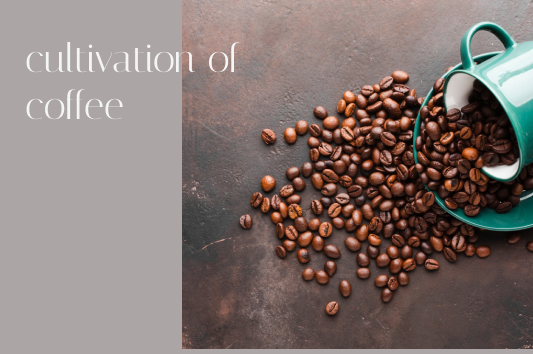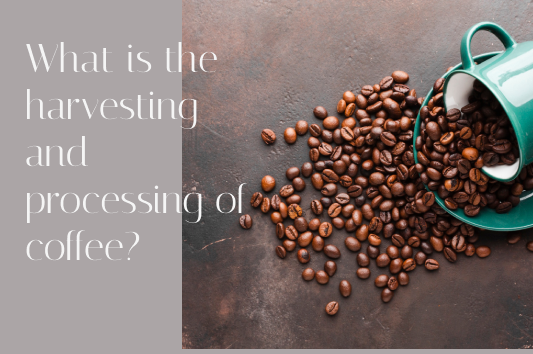Coffee production
Coffee production is the process of growing coffee plants, harvesting the beans, and processing them to be ready for export and consumption..Many of us love sipping coffee, but ever wonder how it reaches your cup? Believe it or not, coffee starts its journey in far-off fields, vital to over 25 million people’s survival.
This blog will guide you through the incredible process from seedling to your morning brew. Get ready for a bean-to-cup adventure!

What is the cultivation of coffee?
The cultivation of coffee refers to the systematic and intentional process of growing coffee plants for the purpose of harvesting coffee beans. This involves various agricultural practices such as selecting suitable varieties of coffee plants, preparing the soil, planting, tending to the plants, and ultimately harvesting the coffee cherries. The cultivation process is influenced by factors such as climate, altitude, soil conditions, and cultivation methods.

Traditionally, coffee has often been grown in the shade of other trees, replicating the natural conditions found in a forest understory. This approach, known as shade-grown coffee, aims to mimic the plant’s native habitat and can contribute to environmental sustainability. However, modern coffee cultivation methods also include sun cultivation, where coffee plants are grown in full sunlight. The choice of cultivation method can impact factors such as flavor profile, environmental impact, and overall yield. Overall, coffee cultivation involves a combination of scientific knowledge, environmental considerations, and traditional agricultural practices.
How many types of coffee plants are there?
There are over 100 different species of coffee plants, but the two most commercially significant and widely cultivated species are Coffea arabica (commonly known as Arabica) and Coffea canephora (commonly known as Robusta). These two species dominate the global coffee market due to their favorable characteristics and distinct flavors.
- Arabica (Coffea arabica): Arabica coffee is considered the higher quality and more preferred species among coffee enthusiasts. It is known for its smoother, more nuanced flavors with a wide range of aromatic profiles. Arabica plants thrive at higher altitudes in cooler temperatures, typically between 2,000 and 6,000 feet (600 to 1,800 meters).
- Robusta (Coffea canephora): Robusta coffee is hardier and more resistant to pests and diseases than Arabica. It has a stronger, more bitter taste compared to Arabica and contains more caffeine. Robusta plants are well-suited to lower altitudes and warmer climates, typically growing at altitudes below 2,000 feet (600 meters).
While Arabica and Robusta are the main players in the coffee industry, there are other less common and lesser-known species, including Liberica (Coffea liberica) and Excelsa (Coffea excelsa or Coffea liberica var. liberica). However, these varieties have limited global production and market share compared to Arabica and Robusta. The choice between Arabica and Robusta often depends on factors such as flavor preferences, growing conditions, and market demand.
Is coffee grown in the shade better than the sun?
Shade-grown and sun-grown coffee refer to the different methods of cultivating coffee plants. Shade-grown coffee is grown under a canopy of trees, providing a natural shade for the coffee plants.
This method helps in preserving the natural habitat and biodiversity since it promotes the growth of other plant species alongside the coffee plants. On the other hand, sun-grown coffee is cultivated in open areas without much shade, allowing for more direct sunlight exposure to the coffee plants.
However, this method may lead to deforestation and loss of habitat for wildlife.
Shade-grown coffee production not only supports ecological diversity but also contributes to higher-quality beans. The slower maturation process due to less direct sunlight results in denser beans with richer flavors.
What is the common disease in coffee?
Coffee plants are susceptible to various diseases, and the prevalence of these diseases can depend on factors such as climate, cultivation practices, and the specific coffee species being grown. Some of the common diseases affecting coffee plants include:
- Coffee Leaf Rust (Hemileia vastatrix): This is one of the most economically damaging diseases for coffee production. Coffee leaf rust is a fungal infection that manifests as yellow-orange powdery spots on the leaves, ultimately leading to defoliation and reduced yield. Arabica coffee is particularly susceptible to this disease.
- Coffee Berry Disease (Colletotrichum kahawae): This is caused by a fungus that infects coffee berries, leading to their premature drop. The infected berries exhibit dark lesions and may become mummified. This disease can significantly impact the quality and quantity of the coffee harvest.
- Coffee Wilt Disease (Gibberella xylarioides): Also known as Tracheomycosis, this disease affects the vascular system of the coffee plant, causing wilting and death. It is a particularly serious threat to robusta coffee plants.
- Coffee Root-Knot Nematode (Meloidogyne spp.): Nematodes are microscopic worms that can infest the roots of coffee plants, causing the formation of galls or knots. This leads to reduced nutrient uptake and stunted growth.
- Coffee Brown Eye Spot (Cercospora coffeicola): This fungal disease affects the coffee leaves, causing small, dark spots with light centers. Severe infections can lead to defoliation and a decrease in yield.
- Coffee Bacterial Blight (Pseudomonas syringae pv. garcae): This bacterial disease affects both Arabica and Robusta coffee, causing dark lesions on leaves and cherries. It can lead to defoliation and a decrease in yield.
What is the harvesting and processing of coffee?
The harvesting and processing of coffee involve several steps, from picking the ripe cherries to preparing the beans for roasting. The exact methods can vary depending on factors such as the type of coffee, local traditions, and the desired flavor profile. Here’s a general overview of the coffee harvesting and processing process:

1. Harvesting:
Timing: Coffee cherries are typically harvested once they have ripened, which can take several months after flowering. The timing of the harvest is crucial as underripe or overripe cherries can affect the quality of the beans.
Methods:
- Selective Picking: In regions where high-quality coffee is the goal, cherries are selectively picked by hand. Skilled pickers only harvest the ripe cherries, leaving unripe and overripe ones on the tree.
- Strip Picking: In areas where large-scale production is the focus, mechanical harvesters may be used to strip all cherries from the tree regardless of ripeness. This method is faster but can result in a mix of ripe and unripe cherries.
2. Processing:
Wet Processing (Washed Coffee):
- Pulping: The outer pulp is removed from the cherries, usually with a machine. The beans are then separated from the mucilage.
- Fermentation: The beans are left to ferment in water, which helps remove any remaining mucilage. This stage can last for a few hours to a couple of days.
- Washing and Drying: The beans are thoroughly washed and then dried in the sun or using mechanical dryers.
Dry Processing (Natural Coffee):
- Drying: Whole cherries are spread out in the sun to dry. This can take up to several weeks. During this time, the cherries are turned regularly to ensure even drying.
- Hulling: Once the cherries are completely dried, the outer layers (husk, pulp, and parchment) are mechanically removed to reveal the green coffee beans.
Semi-Washed Processing (Pulped Natural):
- Pulping: Similar to the wet process, the outer skin is removed, but some mucilage is intentionally left on the beans.
- Drying: The beans with the remaining mucilage are dried. This method combines elements of both wet and dry processing.
3. Milling and Sorting:
Milling: The dried beans are hulled to remove the parchment layer, and the green coffee beans are obtained.
Sorting: The beans are sorted based on size, weight, and quality. Defective or underdeveloped beans are removed.
4. Export:
The processed coffee is then packaged and prepared for export. The beans are often graded based on quality, and they may be stored in bags or bulk containers for shipment to coffee roasters around the world.
5. Roasting:
Upon reaching the destination, coffee beans are roasted to develop the characteristic flavors and aromas associated with the final product.
6. Brewing:
Finally, the roasted coffee is ground and brewed to produce the beverage enjoyed by coffee lovers worldwide.
Each step in the process contributes to the final flavor and quality of the coffee, and variations in these methods can result in unique characteristics for different coffee varieties and origins.
What is the difference between hulling and milling?
In the context of coffee processing, “hulling” and “milling” refer to specific stages that involve the removal of different layers from the coffee beans. While both processes contribute to preparing coffee for consumption, they have distinct purposes and occur at different points in the overall processing sequence. Here’s an explanation of the differences between hulling and milling coffee:
Removing the outer layers of the bean
After the coffee beans have been dried, they undergo milling and hulling to remove the outer layers of the bean. The first step involves removing the parchment layer that surrounds the bean.
This is followed by polishing and cleaning to get rid of any remaining layers. After this, grading and sorting are done to ensure that only quality beans make it through for further processing.
The process of milling and hulling ensures that only the inner seed or “bean” is left behind for roasting. It plays a crucial role in maintaining the quality and flavor of the coffee beans as they move towards the final stages of production such as roasting, grinding, and brewing.
Polishing and cleaning the beans
After the beans have been hulled, they go through a process of polishing and cleaning. Polishing involves removing any silver skin that remains on the beans after hulling. This is done to improve their appearance and smoothness.
The next step is cleaning, where the beans are sorted using water channels or air classifiers to remove any remaining debris or impurities. Both these processes ensure that only high-quality beans move forward in the production process.
The polishing and cleaning stage plays a crucial role in ensuring that only the best coffee beans proceed for further processing. Through this meticulous procedure, any imperfections are removed from the beans, resulting in a superior quality final product for consumption by coffee lovers worldwide.
Grading and sorting the beans
After the milling and hulling process, coffee beans are graded and sorted according to their size, weight, and quality. This step is crucial in determining the value of the beans in the market.
The grading process involves carefully examining each bean for defects or imperfections while sorting separates the beans based on their size and density. For instance, a higher grade typically means larger and denser beans which fetch a better price in the market.
With different sizes and densities come different flavors and aromas, making grading and sorting an essential part of delivering consistent quality to consumers.
With over 25 million people globally relying on coffee farming for their livelihoods, ensuring that every bean meets specific standards is vital for both farmers’ income and consumer satisfaction.
What are the major steps in production of coffee?
The production of coffee involves several key steps, from cultivation to harvesting, processing, and preparation for consumption. Here are 20 major steps in the production of coffee:
- Cultivation: Selecting suitable varieties of coffee plants and preparing the land for planting.
- Planting: Planting coffee seedlings in prepared soil, often in rows or shaded arrangements.
- Pruning: Trimming and shaping coffee plants for optimal growth and yield.
- Harvesting: Picking ripe coffee cherries from the coffee plants, either selectively by hand or using mechanical harvesters.
- Sorting: Sorting harvested cherries to separate ripe, unripe, and overripe ones.
- Processing (Wet/Washed): Removing the outer pulp from the cherries, fermenting, washing, and drying the beans.
- Processing (Dry/Natural): Drying whole cherries in the sun, then hulling to remove husk and parchment.
- Processing (Semi-Washed/Pulped Natural): Partially removing pulp, drying with some mucilage, and then hulling.
- Milling: Removing the parchment and any remaining layers from the dried beans.
- Grading: Sorting coffee beans based on size, weight, and quality.
- Bagging: Packaging the processed coffee beans in bags for transport.
- Export: Shipping the bags of green coffee beans to importing countries.
- Roasting: Subjecting the green coffee beans to heat, developing flavors and aromas.
- Grinding: Crushing roasted coffee beans into the desired particle size for brewing.
- Brewing: Preparing coffee by extracting flavors from ground coffee beans using hot water.
- Packaging: Packaging ground or whole bean coffee for retail or commercial distribution.
- Distribution: Transporting packaged coffee to retailers, wholesalers, or consumers.
- Quality Control: Conducting tests and checks to ensure the coffee meets quality standards.
- Marketing: Promoting and advertising coffee products to consumers.
- Consumption: Enjoying coffee through various brewing methods, such as drip, espresso, or French press.
What is the last step in coffee bean production?
Roasting the beans is a crucial step in bringing out the flavor of coffee, and understanding the different brewing techniques can enhance the overall coffee experience. To learn more about the final stages of coffee production, keep reading!
Roasting the beans
Roasting the beans is a crucial step in coffee production. The green coffee beans are heated, causing chemical changes that bring out the rich flavors and aromas we associate with our favorite brew.
During roasting, the beans lose moisture and increase in size, turning from green to brown. The duration of roasting affects the flavor profile; longer roasting times result in darker and more intense flavors while shorter times produce lighter and fruitier notes.
As the beans roast, they undergo a process called pyrolysis which transforms their chemical composition. This results in the formation of over 800 aromatic compounds that give coffee its distinct taste and smell.
Tasting and evaluating the coffee
Coffee tasting, also known as “cupping,” involves evaluating the aroma, flavor, and aftertaste of brewed coffee. It’s a meticulous process performed by professional tasters to assess the quality and characteristics of different coffee beans.
The tasters use specialized spoon-like cups to slurp the coffee loudly so that it spreads across their entire palate, allowing them to detect subtle flavors and nuances. These evaluations help determine the best brewing methods for specific beans as well as their market value based on their taste profiles.
Factors such as acidity, body, and balance are carefully considered during this fascinating sensory experience.
When considering the grading and sorting of coffee beans, factors like size, color, density, and defects are taken into account to separate high-quality beans from lower-grade ones.
Grinding and brewing techniques
After the coffee beans are roasted, they are ready for grinding and brewing. The grinding process involves breaking down the roasted beans into smaller particles to increase their surface area and extract flavor during brewing.
Different brewing methods require different grind sizes – for example, a coarse grind is suitable for French press while espresso requires a fine grind. Consistency in grind size is essential to ensure even extraction of flavors.
When it comes to brewing techniques, there are various methods such as drip brew, pour-over, French press, and espresso machines. Each method influences the taste and strength of the brewed coffee.
Packaging and distribution
Coffee packaging is an essential step in the journey from bean to cup. Once the coffee beans are roasted and ready for market, they are packaged to preserve their freshness and flavor.
The packaging process ensures that the coffee reaches consumers in optimal condition, maintaining its quality and aroma. From bags to cans and even single-serve pods, there are various packaging options available depending on consumer preferences and market trends.
After the packaging stage is complete, distribution comes into play. Coffee distribution involves transporting the packaged product from the production facility to retailers, wholesalers, or directly to consumers through online platforms.
Conclusion
In conclusion, the journey of coffee from plant to cup is a fascinating process involving careful cultivation, harvesting, and meticulous processing. With over 50 countries involved in its production, coffee plays an essential role in the global economy and provides livelihoods for millions of people.
In the context of finding the best coffee, understanding this intricate journey becomes crucial. The meticulous care taken in cultivation, the precision involved in harvesting, and the expertise applied in processing all contribute to the unique flavors and qualities found in premium coffee beans. From the moment the cherries are picked to when they are roasted, ground, and brewed, each step is a crucial part of ensuring the best possible coffee experience.
This rich history and intricate process of coffee production not only contribute to the beverage’s esteemed status but also enhance the appreciation for the artistry involved in crafting the perfect cup. The diversity of coffee varieties, processing methods, and roasting techniques offers coffee enthusiasts a wide range of options to explore and savor. So, when seeking the best coffee, one can appreciate not only the final result in the cup but also the journey that transforms a humble cherry into a delightful and complex beverage.

